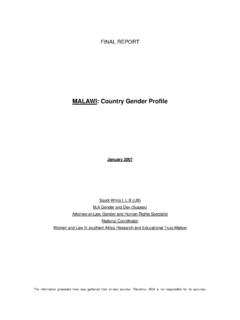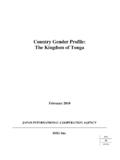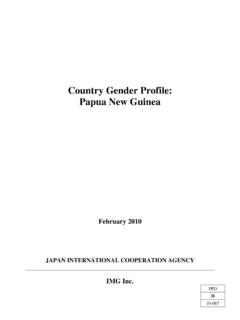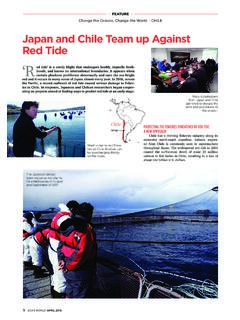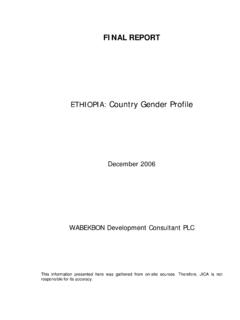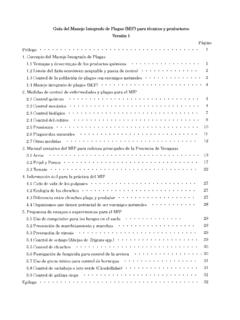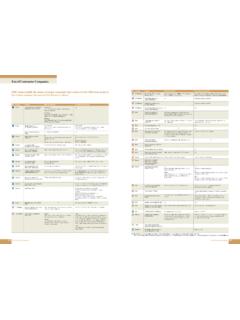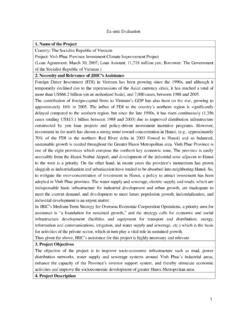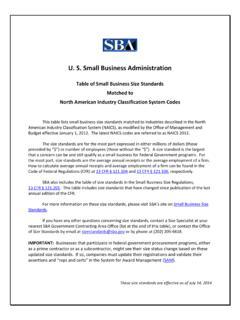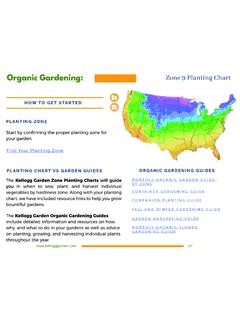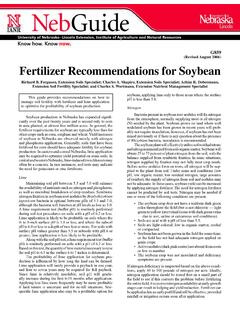Transcription of RICE CULTIVATION HANDBOOK - JICA
1 -1-NATIONALAGRICULTURALRESEARCHORGANISAT IONRICE CULTIVATION HANDBOOKNERICA PROMOTION PROJECT,NATIONAL CROPS RESOURCESRESEARCH INSTITUTE(NaCRRI) 7084, Kampala, UgandaPhone: 041-573016E-mail: of Contents1. rice -Riceintheworld-5- rice Varieties in the world-5- rice CULTIVATION in Uganda-5- Botanical Name of rice -5- Classification of Seed-6- Seed Dormancy-6-Germination-6- Seeding Emergence-6-RiceGrowingStage-7-Germinati onTest-7- Seed Selection at planting -7- Seed Production-82. Upland rice CULTIVATION - Upland rice Varieties-9- What is NERICA?-9- Characteristics of NERICA-10- Rainfall and Fields-11- Upalnd NERICA at Slope(at Harvest)-12- Water Harvest Technology-13- Upland rice planting in the Paddy Fields-14-SoilpHforRice-14- planting Methods-15-PlantingSpacingandSeedRate-16 -SowingDepth-16- Intercropping with other crops-18- refilling of Missing Hills-18- Fertilization-19- Weed Control in Upland rice Field-19-RatoonCrop-20-4-3.
2 Lowland rice CULTIVATION - Transplanting of rice -21- Land Preparation-21- Seed Preparation-22- Seedbed Preparation and Seedling Management-22- How to Transplant-24- Plant Spacing-25- Refilling of Missing Hills-26- Fertilization(Amount and Timing)-264. Harvest and Post Harvest- Harvesting-27- Threshing-27- Winnowing and Drying-28- rice Milling-295. Soil Management- Fertilizer-30- Use of Organic material/Manure-326. Plant Protection- Weed Management-33-Herbicide-34-InsectPestofR ice-35-DiseasesofRice-38 Appendix-1: Cost Benefit Analysis for one acre of Upland rice CULTIVATION -43 Appendix-2: Cost Benefit Analysis for one acre of Lowland rice CULTIVATION -44 Appendix-3: Uganda Suitability Map for NERICA CULTIVATION -45 Appendix-4: Rainfall Patterns in Uganda-46-5-RICERice in the worldThe rice planted area in the world is 157,000,000 haIts production in the worild is about 650,000,000 the world population eats it as staple varieties in the are 76,000 rice varieties in the International rice Germplasm Center atInternational rice Research Institute(IRRI).
3 rice CULTIVATION in Uganda(2008 estimated) rice CULTIVATION area: 110,000 haRainfed lowland : 65,000 haIrrigated lowland :5,000 haUpland: 40,000 haProduction(Paddy) 170,000 t(Milled rice ): 102,000 tRice importation 60,000 tRice consumption 162,000 tPar capita consumption(kg / year) kgRiceprice:2,000 Ush/kg=$ name of riceOryza sativaL.(Asia rice ),Oryza glaberrimaSteud.(Africa rice )Oryza , Supa, IR-64, etcJaponicaKoshihikari, Nihonbare, etcJavanicaNARIC-2,Moroberekan, etc.(= tropical japonica)Oryza nivaraSharma et ShastryOryza longistaminataA. Chev et riceabout 20 wild rice in the sativaL. has 3 types namely indica, japonica and tropical of SeedBreeder seed:Kept by breeder or breeding seed: Multiplied from breeder seeds at research station seed: Seed produced by a seed center / seed:Seed growen in seed grower's DormancyDormancy can prevent germination of grains onthe panicle when panicles are period: 0 8weeksBreaking dormancy: heat 50 Cfor 4-5 days.
4 (Do not close up the container of seeds)Practical method: dry on the concrete floor for2-3 daysGerminationWhen the tip of coleoptile emerges from stage Activation stage Post germination growth stage0-18 hours18-72 hours72 hours (at 20 C)When moisture content of seed is 30-40 % germination than 8 Cand more than 45 Cno germinationSeedling EmergenceTip of the seedling emerges from the Optimum temperature for seedling emergence is 25 - 30 C. Higher than 40 Cseedlings die. Lower than 10 Cseedlings can not of seedlings need 5-6 ppm of oxygen: Root growth is poor andcoleoptile shows abnormal : under enough O2right: under lack of O2-7- rice Growth StageVegetative growth:Germination Panicle initiation60 daysReproductive growth: Panicle initiation Heading30 daysHeading Maturity30 days(milky dough yellow ripe maturity)Germination TestBefore sowing, a germination test should be done to ensure 80% following procedure should be used;If the germination percentage is lower than 80%, then use a higher seed rate.
5 Count 100 seedsSoak seeds for 24 hoursWrap in wet paper Count the number of seeds2 days after incubation Incubate for 2 daysSeed Selection at PlantingIt is difficult to determine seed viability withthe naked eye. It is advisable to carry outseed selection using the floatation sunken seeds (filled grain) with highpotential to germinate from those that float (emptygrain) that are unable to ProductionSince rice is self-pollinated plant, rice seed can be produced by plant 200 50 kg of seed can be harvestedGenetic purity of rice varieties can be maintained by removing the off-typesdetected in the fieldSome characteristics for identifying off-typesStem ColourTime to maturityApiculus Colourwithout awnwith awnPurification through removal of off-types ensures uniformity in growth andstability of yields of rice CULTIVATIONU pland rice VarietiesNARO/NaCRRIhas released 5 Upland rice Varieties being grown by are more superior to the previous varietyAbilony(IRAT 112).
6 NARIC 1(ITA 257): Maturity 115 - 120 daysYield 4 t / haNARIC 2(ITA 325): Maturity 115 - 120 daysYield 3 - t / haNERICA 4(NARIC 3):Maturity110-120days Yield4-5t/haThis variety is also known as SUPARICA 2 NERICA 1: Maturity 105- 115 days. Yield 3-4t/ha 10: Maturity 100 - 105 days Yield 3-4 t / ha Grain with long awnNERICA 1 NERICA 4 NERICA 10 Note: However, yields of upland rice depend largely on the rainfall pattern andgood agronomic practices like weeding and is NERICANERICA =NEwRICeforAfricaNERICA is the product of interspecific hybridization between the cultivated ricespecies of Africa and was developed by scientists from WARDA(Dr. Monty Jones)in the rice (WAB-56-104) XAfricanRice(CG-14) -10-Characteristic of NERICA: Early maturity: 90-100 days Drought tolerance Resistance to rice blast diseaseNERICA-4 has panicles, K-85 not yet heading Secondary branches on panicles many grains(300 grains / panicle)Big paniclesNERICA-4 317 grains Resistance to rice Yellow Mottle VirusWith RYMV symptomNo RYMV symptom18 days after inoculation-11-Rainfall and FieldsYou have to check rainfall pattern in your area.
7 (Please see appendix)Upland rice grow well where 5 days total rainfall is more than 20 mm fromsowing to 15 days before harvesting (about 90 days).Field location should preferably be in the low lying areas since these areas havemore water available to sustain rice to is advisable to make bands around the field to avoid rain water from at NaCRRI, Namulonge(See Appendix 4 for other areas)Water Application Trial at NaCRRI107 Days after sowing15 mm / 5 days25 mm / 5 daysNo panicleWith many panicles-12-Effect of Water Application on Yield of NERICA-4 Upland NERICA at a slope(at harvest) mWater Table30 mRice planted where water table is less than 70 cm shows good performance andhigher table is easily known where you dig the application and Yield04815473903468201,0002,0003,0004,00 05,00010mm/5days15mm/5days20mm/5days25mm /5days30mm/5daysWater applicationYield (kg / ha)-13-Water Harvest TechnologyTerracing in slopeAt terrace: no missing hillAt no terrace.
8 Many missing hillsThese missing hills are due to seeds were washed away by heavy rice planting in the Paddy NERICA perform well under paddy condition (with standing water).Soil pH for RiceRice does not perform well with soil whichhas pH or of soil in Uganda has no problem except few MethodsThere are 3 methods of planting upland rice namely; Drill, Dibble, and Dibbling allow straight row planting that ensures optimum plantpopulation and use of a hoe for weeding. Straight row planting can be achievedby using a planting rope or using line 's practice(drill)Sow 50-60 seeds for 1mA forked-rake for rice drill-plantingA wooden rake for drill planting -16-Plant Spacing and Seeding RateMethodPlant spacing hills / seed / hillSeeding rate / ha Seeding rate /acreDrill30 cm x cm1851 seed / hill50 kg20 kgDibble30 cm x cm seeds / hill50 kg20 kgGermination and Emergence of Upland Rice3daysaftersowingGerminated4 days after sowingIt takes 5 days to emerge from the soil days after sowingEmerged!
9 Sowing DepthIt is recommended that upland rice be planted at a depth of between 3 - 4 at a depth of more than 5 cm has been observed to result in lowgermination, delayed emergence, delayed maturity and thus low weeks after sowing4 weeks after sowing-17-Emergence % at different sowing depthMaturity is delayed where sowed develop secondary roots due to lack ofoxygen, therefore growth is 2cm 3cm 4cm 5cm 6cmGerminationSowing Depth-18-Intercropping with Other CropsUpland rice can be intercropped with maize, soybeans, banana and maizewith soybeanwith coffeewith bananaRefilling of Missing HillsMissing hills lead to low yield. It is therefore advisable that you set a smallnursery bed beside the mother garden to raise seedlings for purposes of refillinggaps. Gap filling should be done 15-20 days after sowing and it s important towater the seedlings after should not be continuously grown on the same fields, it should be rotatedwith other crops to conserve soil organic material such as rice straw and animal manure can be addedto the soil to supplement soil rates and regimes55-23-0 NPK kg / ha*DAG(Days After Germination)Fertilizer15-20 DAG55-65 DAGDAP(18-46-0)50 kg / ha(20 kg / acre)0 Urea(46-0-0)50 kg / ha(20 kg / acre)50 kg / ha(20 kg / acre)Weed Control in Upland rice FieldsWeeding must be done at least twice (2 times)
10 At 3 and 6 weeks should be removed before they produce of Weeding Frequency on Yield of NERICA-4 Effect of Weeding on rice Yield93818922463448652750100020003000400 050006000 NoweedingWeedingonceWeedingtwiceWeeding 3timesWeed freeYield kg / ha-20-No weeding2 times weedingWeed freeFarmers weeding practiceStriga(paracitic weed)Ratoon CropAfter harvest, rice plant produce new shoot and 1 - 2 t / ha can be harvested within 60 days after of harvested rice plant(stubble)should be 15-25 cm. First Crop(120 days)Ratoon crop(50-60 days)-21-LOWLAND rice CULTIVATIONT ransplanting of RiceAdvantage of transplanting method: Reduce weed problems. Planted seedlings are about 3 weeks old by the time weed seeds germinate. Rotaryweedercanbeusediftransplantedinstr aightrows. Reduce lodging problemDisadvantage of transplanting method: Seedbed preparation and transplanting cost/labour are preparationA well-prepared field has the following advantages: Controls weeds and recycles nutrients through the decomposition of ricestubble and weeds which are incorporated into the soil.
